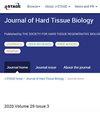生物活性物质无定形磷酸钙溶解度随时间变化及羟基磷灰石沉淀的研究
IF 0.4
4区 医学
Q4 ENGINEERING, BIOMEDICAL
引用次数: 2
摘要
在这项研究中,我们将无定形磷酸钙(ACP)粉末浸入生化缓冲溶液中,并对其溶解度和沉淀物的相变进行了分析。在制备出不含杂质的ACP粉体后,我们使用良好的缓冲液之一- 4-(2-羟乙基)-1-哌嗪乙磺酸(HEPES)缓冲液作为缓冲溶液,测定了ACP和其他磷酸钙晶体中钙离子的洗脱量。ACP分别在5°C、20°C和37°C的缓冲液中浸泡,15min至24h测量洗脱钙离子的量。用x射线衍射分析了析出固相,并用透射电镜观察了析出固相的形貌。在HEPES缓冲液中放置15 min,观察羟基磷灰石(HAp)的沉淀。此外,在本实验组中,样品的沉淀物在HEPES缓冲液中37℃孵育24 h产生最大的HAp晶体。实验结果表明,ACP在HEPES缓冲液中容易释放钙离子和磷酸离子,并发生快速相变。此外,我们认为除了热力学效应外,缓冲溶液还促进了HAp的晶体生长。本文章由计算机程序翻译,如有差异,请以英文原文为准。
Studies on Change in Solubility over Time of the Bioactive Material Amorphous Calcium Phosphate and Precipitation of Hydroxyapatite
In this study, we immersed amorphous calcium phosphate (ACP) powder in biochemical buffer solutions and performed analysis of its solubility and phase transformation of the precipitate. After preparing ACP powder that contains no impurities, we used 4-(2-hydroxyethyl)-1-piperazinetethanesulfonic acid (HEPES) buffer, one of the good buffers, as a buffer solution and measured the amount of calcium ions eluted from ACP and other calcium phosphate crystals. ACP was immersed in the buffer solution at 5°C, 20°C, and 37°C, and the amount of eluted calcium ions was measured from 15 min to 24 h thereafter. The precipitated solid phase was analyzed using X-ray diffraction and its morphology was observed using transmission electron microscopy. The precipitation of hydroxyapatite (HAp) was observed after 15 min in HEPES buffer solution. Furthermore, in this experimental group, the precipitates of the sample incubated in HEPES buffer solution at 37°C for 24 h produced the largest HAp crystals. From these results we concluded that ACP immersed in HEPES buffer solution easily releases calcium ions and phosphate ions, and a rapid phase transformation to HAp occurs. Moreover, we assume that, in addition to the thermodynamic effect, the crystal growth of HAp is enhanced by the buffer solution.
求助全文
通过发布文献求助,成功后即可免费获取论文全文。
去求助
来源期刊

Journal of Hard Tissue Biology
ENGINEERING, BIOMEDICAL-
CiteScore
0.90
自引率
0.00%
发文量
28
审稿时长
6-12 weeks
期刊介绍:
Information not localized
 求助内容:
求助内容: 应助结果提醒方式:
应助结果提醒方式:


